Chickpeas are a staple in many diets, but they can be overwhelming for people with chronic kidney disease. Chickpeas do have potassium and can be high in sodium, which is why it’s important to know how they can fit into a renal diet. The health benefits of adding chickpeas to the diet outweigh the potassium concerns because it provides a protein and fiber combo that’s hard to find elsewhere. Let’s explore how to include them in your renal diet!
Table of Contents
About Chickpeas
Chickpeas, also known as garbanzo beans, are a type of legume. They were originally part of the Meditteranean, Middle Eastern, and African diets, but have become popular worldwide.
They come in both dried and canned/cooked options. Both options are inexpensive, although dried chickpeas are a bit cheaper since the cooking still needs to be done.

Nutritional Value of Chickpeas
A serving of chickpeas is 1/2 cup cooked, or 1/4 cup dry. Here’s the nutritional breakdown of cooked from dry chickpeas:
- Calories: 135
- Protein: 7 grams
- Total fat: 2 grams
- Carbohydrates: 23 grams
- Fiber: 6 grams
- Sugars: 4 grams
- Added sugars: 0 grams
- Sodium: 5 milligrams
- Iron: 2.5 milligrams
- Phosphorus: 138 milligrams
- Potassium: 238 milligrams
- Calcium: 40 milligrams
- Magnesium: 40 milligrams
- PRAL: 3.1 mEq/d
Canned chickpeas have a slightly different nutrition breakdown. Here’s the nutritional value of a 1/2 cup serving from canned chickpeas:
- Calories: 118
- Protein: 6 grams
- Total fat: 2 grams
- Carbohydrates: 19 grams
- Fiber: 5 grams
- Sugars: 3 grams
- Added sugars: 0 grams
- Sodium: 207 milligrams
- Iron: 0.9 milligrams
- Phosphorus: 72 milligrams
- Potassium: 106 milligrams
- Calcium: 38 milligrams
- Magnesium: 13 milligrams
- PRAL: 1.4 mEq/d
As shown here, the canned chickpeas are lower in both phosphorus and potassium compared to dried, cooked chickpeas.
This is because the canning process actually removes some of the nutrients from the garbanzo bean and into the canning liquid.
Both options are high-quality plant-based proteins and contain fiber, potassium, magnesium, and zinc. Chickpeas also have a low glycemic index, meaning they won’t cause a spike in blood sugar.
Note that the sodium in canned can be considerably higher, so look for low sodium canned chickpeas when possible. Draining and rinsing chickpeas can also help reduce the sodium content of chickpeas.
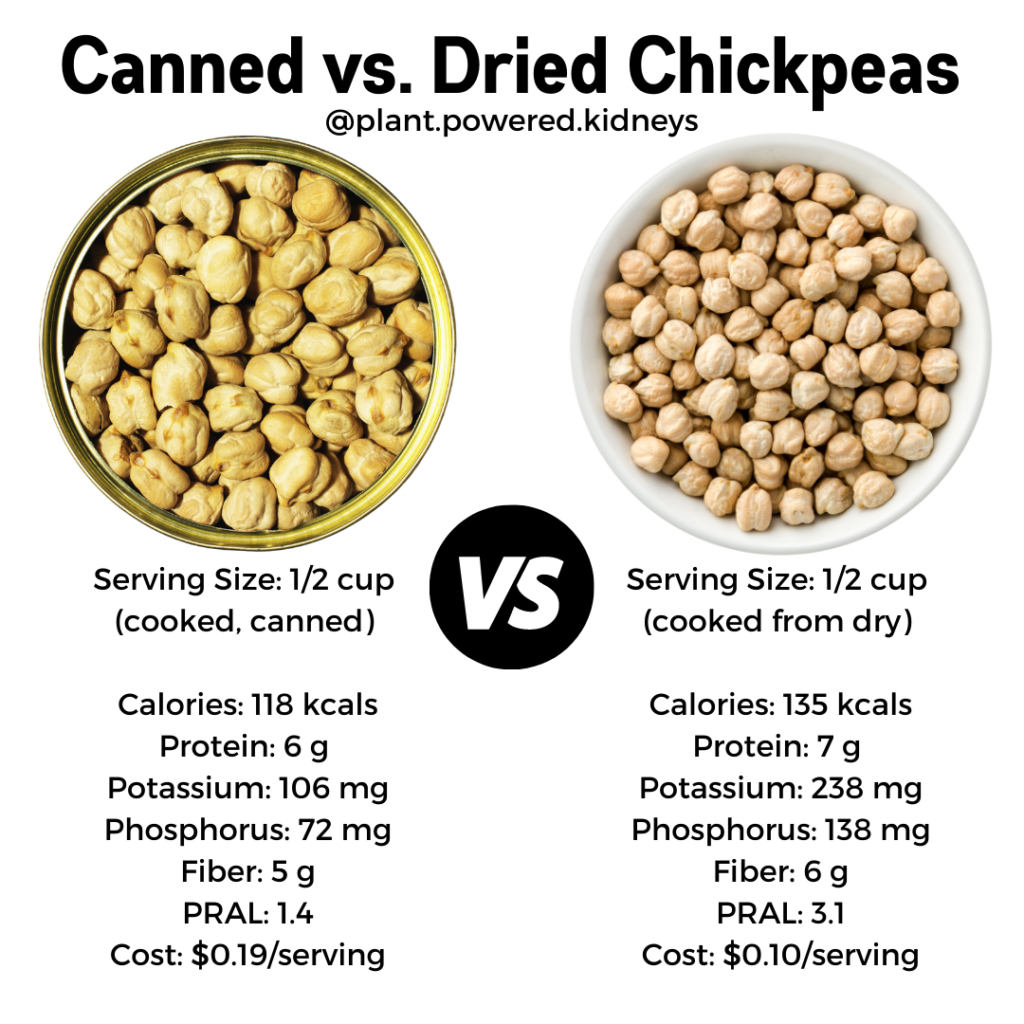
Potassium in Chickpeas
A high potassium food is considered to be equal to or greater than 200 milligrams of potassium per serving.
While the cooked-from-dry chickpeas are considered a high potassium food, the canned chickpeas are low potassium.
However, if potassium is a concern, there are scientifically proven ways to lower the potassium in chickpeas.
Cooking to Reduce Potassium
Research has shown that different cooking methods can also help reduce the amount of potassium in chickpeas and other legumes.
A study from 2018 looked at soaking, pressure cooking, and normal cooking chickpeas and other legumes. Analysis shows that potassium could be leeched by up to 80% from dry chickpeas and up to 95% from canned chickpeas.
Phosphorus in Chickpeas
A high phosphorus food is considered to be at or greater than 350 milligrams of phosphorus per serving.
The cooked-from-dry chickpeas are a high phosphorus food, while the canned chickpeas are low phosphorus. Again, this is because of the canning process which removes some of the nutrients from the garbanzo bean and into the canning liquid.
Cooking to Reduce Phosphorus
In the same study, it was seen that the phosphorus content of chickpeas was not reduced in a variety of soaking and cooking methods.
Regardless, the phosphorus content of chickpeas is not as concerning as one would imagine. Organic phosphorus absorption is significantly lower than inorganic, or additive, phosphorus.
This is because organic phosphorus sources, such as whole grains, legumes, beans, nuts, and seeds, also have organic compounds called phytates. These phytates prevent the absorption of phosphorus into the bloodstream.
One study looked at total phosphorus and digestible phosphorus in a variety of foods, including chickpeas. The actual absorbable phosphorus in chickpeas was about 38% of the total phosphorus.
The bottom line: chickpeas are not the problem with phosphorus in kidney disease.
Read more about a low phosphorus diet here.
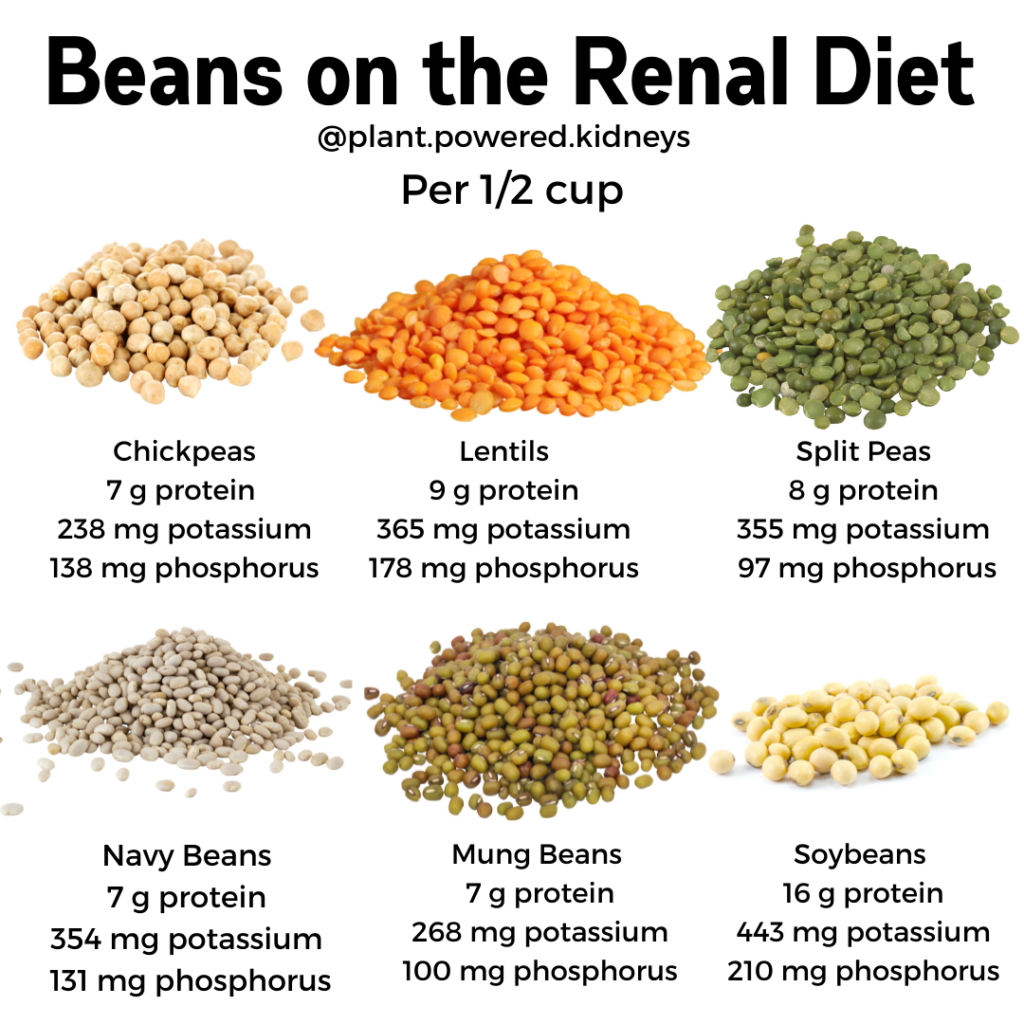
Protein in Chickpeas
Chickpeas are a good source of plant-based protein, providing about seven grams per serving. This is important for those with chronic kidney disease who may need to reduce their animal protein intake.
The combination of protein and fiber in chickpeas makes them an ideal food choice. Protein provides the building blocks for muscles and other tissues, while fiber helps keep us feeling full and reduces the risk of constipation.
Additionally, it’s not a heavy protein food, making it more appropriate for early or late-stage kidney disease. Even those on dialysis can include chickpeas in their renal diet.
Canned chickpeas may be a better option in many cases. This is not only because of the lower nutrient content, but because of that, the PRAL value is lower in canned chickpeas vs dried chickpeas.
How to Cook Chickpeas
There are a few ways to cook chickpeas. The most popular options are boiling, pressure cooking, or using a slow cooker.
Boiling
Bring a pot of water to a boil and add the desired amount of dried chickpeas. Let them cook for about 30-45 minutes or until they’re soft.
Pressure Cooking
Add the desired amount of dried chickpeas to your pressure cooker. Add enough water to cover the chickpeas by an inch or two.
Seal the pressure cooker and bring it up to high pressure. Cook for 12 minutes on high pressure. Release the pressure naturally, which should take about 15 minutes.
Slow Cooker
Add the desired amount of dried chickpeas to your slow cooker. Add enough water that it covers by an inch or two. Cook on high for about 4 hours, then turn the heat to low and cook another 4 -8 hours until they’re soft.
Cooking Chickpeas from Canned
As mentioned, sure to drain and rinse them first. This will help reduce some of the sodium, especially in the regular canned chickpeas.
One of the great things about using canned chickpeas, besides being a low potassium option, is that they are already cooked!
If you prefer, they can be warmed over the stove in water. This, however, is not necessary. Canned chickpeas are great to use in no-cook recipes.
Comparison of Potassium in Chickpeas against other Beans and Legumes
It’s now apparent that the potassium in chickpeas is not as high as many think it is. But how does it compare to other beans and legumes?
Let’s take a look at the potassium in a variety of beans and legumes to see how they stack up.
| Bean/Legume | Potassium (mg) per 1/2 cup serving |
|---|---|
| Chickpeas | 238 |
| Lentils | 365 |
| Split Peas | 355 |
| Navy Beans | 354 |
| Mung Beans | 268 |
| Soybeans | 443 |
| Kidney Beans | 303 |
| Black Beans | 305 |
| Lima Beans | 437 |
| Pinto Beans | 375 |
| Adzuki Beans | 980 |
As you can see, chickpeas are a lower potassium option than many other beans.
It’s important to keep in mind that the potassium content here, provided by the USDA Food Database, does not detail the reduced potassium from the cooking techniques described.
An additional factor to consider is the amount of fiber each type of bean and legume provides. Fiber is an important and helpful factor in keeping potassium levels regulated.
Meal Ideas with Chickpeas
Now that you know a little more about the nutritional values, like potassium in chickpeas, let’s look at some meal ideas that include them.
Chickpea Salad Sandwich
Ingredients:
-One can of cooked chickpeas, drained and rinsed
-One diced green bell pepper or two diced celery stalks
-Two tablespoons diced red onion
-One tablespoon olive oil mayonnaise or vegan mayonnaise
-One tablespoon dijon mustard
-One teaspoon lemon juice
-Salt and pepper to taste
Instructions:
Mash chickpeas in a medium bowl to desired consistency. Add in remaining ingredients, season with salt and pepper as needed. Serve on low-sodium bread for an open-faced or closed sandwich and enjoy!
Chickpea Curry over Rice
Ingredients:
-Two tablespoons coconut oil divided into two portions for sautéing vegetables
-One diced onion
-Three cloves minced garlic
-One teaspoon grated ginger
-One red bell pepper, stem removed, finely chopped
-Two cups low-sodium vegetable broth divided into two portions (or use one can)
-One cup uncooked brown rice (rinse if needed)
-One can of chickpeas, drained and rinsed
-One tablespoon garam masala
-Half a teaspoon turmeric
-One teaspoon salt
-One cup frozen peas
Instructions:
In a large pot or Dutch oven, heat one tablespoon of coconut oil over medium heat. Then add the onion and sauté for about five minutes until it is translucent.
Next, add the garlic, ginger, and bell pepper to the pot and sauté for another five minutes or so. Add two cups of broth (or one can), rice/quinoa, chickpeas, garam masala, turmeric, and salt.
Bring to a boil then reduce heat to low. Cover and simmer for another 35-45 minutes or until the rice is cooked. Stir in peas, then cover again and let them sit for about five more minutes before serving.
Hummus
Ingredients:
-One can of chickpeas, drained and rinsed
-Two tablespoons tahini paste
-Juice of one lemon
-Half a clove garlic finely minced or pressed through a garlic press. (This is optional! Some people are sensitive to the flavor so you may want to leave it out if needed.)
-One tablespoon olive oil
-Salt and pepper to taste.
Instructions:
Combine all ingredients in a food processor. Process until smooth and creamy.
Serve with vegetable sticks or crackers!
Make it a meal by including a balance of vegetables, crackers/bread, and some other satisfying fats like low-sodium olives or nuts.
Chickpea Tacos
Ingredients:
-Two tablespoons olive oil divided into two portions
-One diced onion
-Three cloves minced garlic
-One can of chickpeas, drained and rinsed
-One tablespoon chili powder
-Half a teaspoon cumin
-One teaspoon salt
-Ten large soft taco shells (or more depending on how many you’re serving)
Instructions:
In a large skillet, heat one tablespoon of olive oil over medium heat. Next, add the onion and sauté for about five minutes until it is translucent.
Add the garlic and stir continually for another 30 seconds or so before adding in the chickpeas along with all other ingredients (except taco shells). Stir to combine then turn down the heat to low. Heat the taco shells according to package directions.
Fill each shell with chickpea mixture, then serve topped with your favorite garnishes like lettuce or avocado!
Of course, there are many other meal ideas that include chickpeas you can enjoy on a renal diet for chronic kidney disease. Potassium in chickpeas and carbohydrate content are not an issue when incorporated in healthy portions.
Roasted Chickpeas
Ingredients:
-One can of chickpeas, drained and rinsed
-Two tablespoons olive oil
-One teaspoon smoked paprika
-Half a teaspoon cumin powder
-Half a teaspoon salt
Instructions:
Preheat oven to 375 degrees F. Line a baking sheet with parchment paper or foil then set aside.
In a large bowl, mix together all ingredients until the chickpeas are evenly coated. Spread them out on your prepared baking sheet in an even layer then bake for about 40 minutes or so, stirring every 15 minutes to avoid burning or uneven cooking.
The chickpeas are done when they’re crispy and golden brown.
Switch out the spices for others that you enjoy. Try garlic and onion powder, chili powder and cumin, or even a sweeter version with cinnamon and nutmeg!
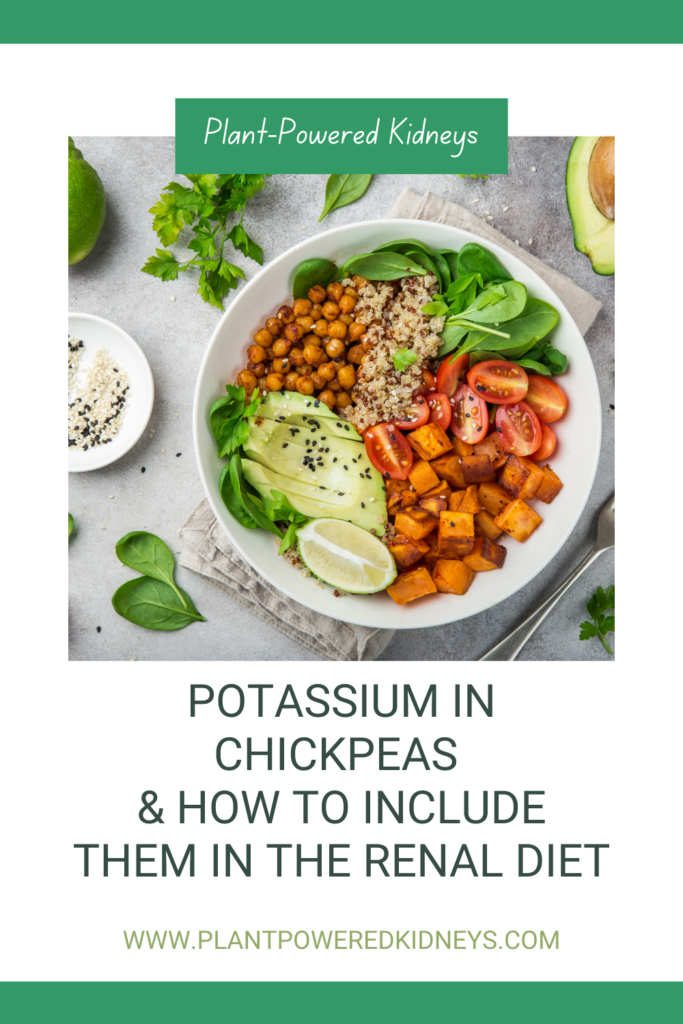
Summary
Chickpeas are a nutritious addition to your renal diet for chronic kidney disease. They are low- to moderate in potassium, but when included in healthy portions, they are not an issue. Chickpeas are also a good source of fiber, protein, and vitamins, and minerals.
The cooking and canning processes can both decrease the amount of potassium in chickpeas. The lowest potassium chickpea options will be canned. Try to get low-sodium chickpeas for the best renal diet option.
Chickpeas can be enjoyed in many different ways, such as hummus, tacos, roasted chickpeas, or just by themselves! Potassium content is not something to worry about with these tasty legumes.


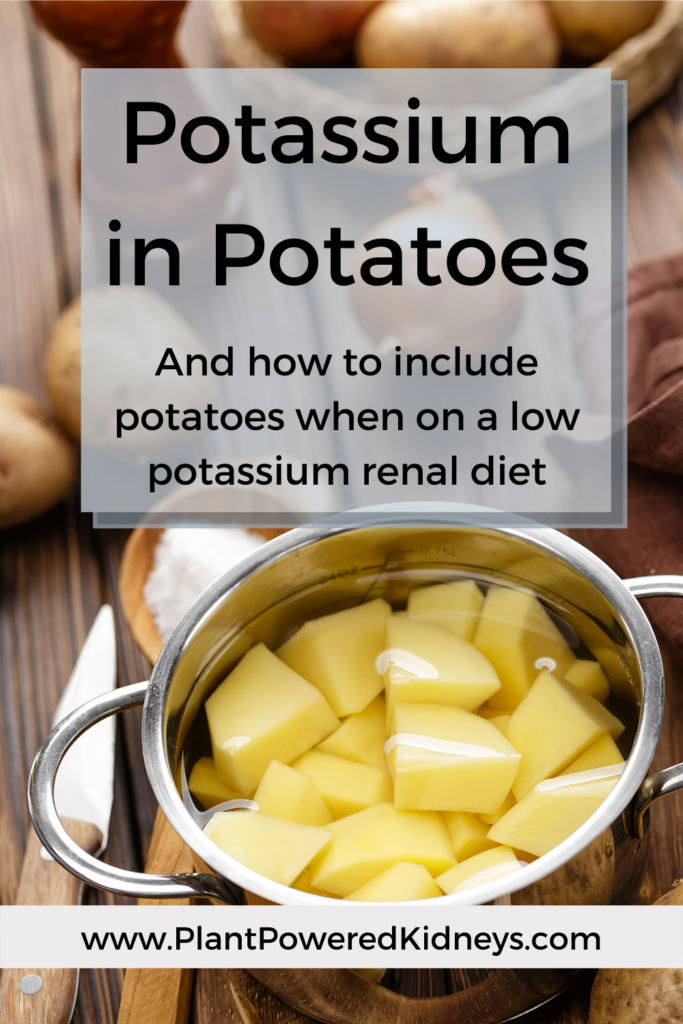
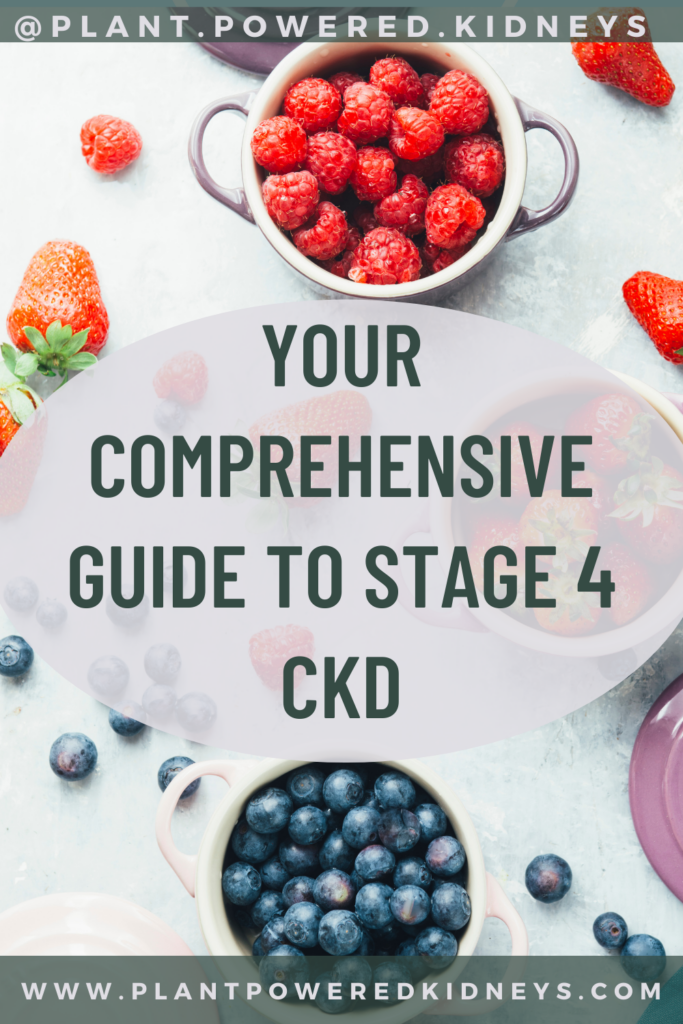
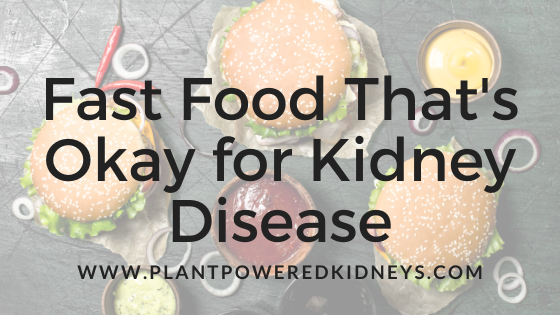
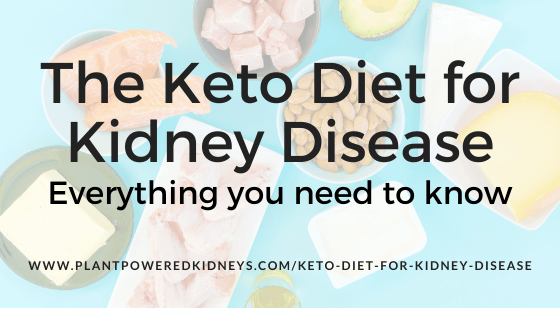
Thank you for important information about beans. Knew they were a good source of protein and fiber, but since stating dialysis I shed away from them because of potassium
& phosphorus.
Now it makes more scene
Thank you.🌹🌹
Oh, I hope you get to enjoy some beans now, Deborah! 😋
I’m so sick of all the CKD recipes that has Sodium and Potassium in high levels. Can some just focus sometimes of giving us recipes including low Sodium and Potassium.
What pasta made with chickpeas? Is it ok!
Chickpea pasta is tasty! You may have to experiment with cooking time to get the desired consistency.
I recently found out that I am in stage 3B for chronic kidney disease so that I am now trying to be aware of my diet and eating habits.
Your information is wonderful, so complete. I appreciate it and have bookmarked the information.
Thanks so much, Kathleen
Thank you for the kind words, Kathleen! We are so happy to be a resource for you. 💚